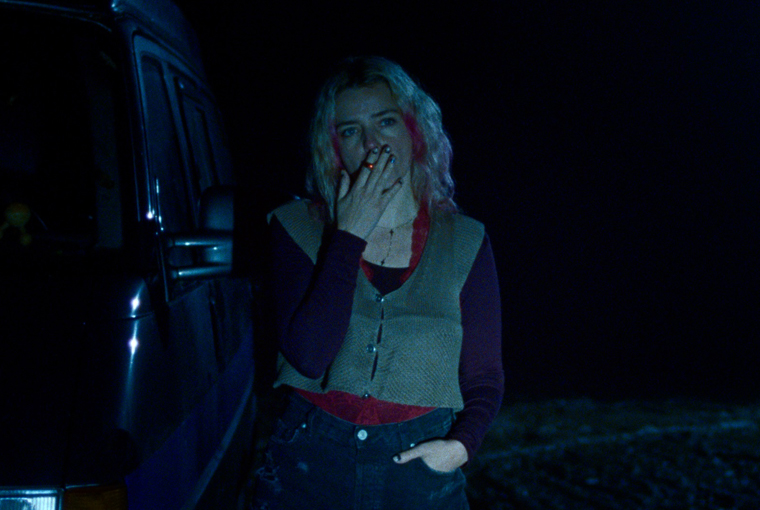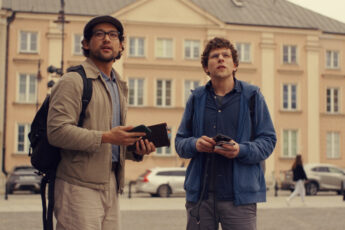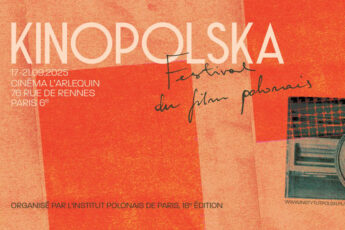When Lesbian Desire Literally Turns to Fire
Julia Kowalski’s Her Will Be Done (Que ma volonté soit faite, 2025)
Vol. 158 (October 2025) by Antonis Lagarias
Naw knows that evil exists. One of her earliest memories is that of a large fire that appears to consume her mother, while several men watch beside her. Julia Kowalski’s Her Will Be Done opens with this flashback scene, ending on a close-up of the little girl’s eyes as she looks at her mother’s ‘purification.’ Then a circle begins. From mother to daughter, evil has now found refuge inside Naw. A leap forward shows Naw having grown into a caretaker for her family, cooking for her ill father and two brothers, tending to the family farm, and caring for the cows. The family lives in a small and muddy French village. As suggested by Naw’s minimal interactions with the locals, they seem to be a family of partly integrated Polish migrants, mingling with the local community through Naw’s brother’s upcoming marriage to a local French girl. Clearly unhappy with this life, she discreetly tries to convince her father to let her study at a veterinary school located fifty kilometers from the family home. For a moment, the story seems like a familiar drama about a young woman in an oppressive family setup who is searching for independence and agency. Then Sandra moves in next door, and along comes disaster.
Sandra (Roxane Mesquida), the main female figure in the film after Naw (Maria Wróbel), represents everything Naw is not. Independent, decisive, and not afraid to speak her mind, she fascinates those around her, mostly due to her defiance and free spirit, expressing a type of female life that is a stranger to local norms. Expectedly, perhaps, she draws the hostility of the entire village, which accuses her of seducing and corrupting the local boys. What is less expected is that Naw’s curiosity about Sandra, quickly turned into desire, unleashes the girl’s strange powers. For Naw’s powers, possibly like her mother’s, are very real. Her dreams are able to alter reality, and even when she tries, she proves unable to control them. Her feelings literally possess her. The religious set-up of the opening scene allows Kowalski to depict desire in unusually dark colors. Naw is a new kind of witch, and her (lesbian) desire is cast as the modern-day sin that threatens the community.
Marxist philosopher Silvia Federici describes the European witch-hunts as a state-orchestrated plan aimed at exterminating everything “capitalism had to destroy: the heretic, the healer, the disobedient wife, the woman who dared to live alone, the obeah woman who poisoned the master’s food and inspired the slaves to revolt.”1 The rhetoric of devil worship was a way of delegitimizing a project to redistribute power. Knowledge, whether in its traditional forms or resulting from paganist practices, could grant respect and influence within a small community, and bonds between women could shape a sense of independence from men. The witch-hunts thus became an effective means to instill fear, eliminate female figures of authority, and confine women to social roles that remain familiar today: carers for the emotional and biological needs of their husbands and children, most often in domestic isolation.
The film draws heavily on witch-hunt imagery, notably through repeated fire scenes and a long night sequence of modern-day hunting. When the villagers collectively turn against Sandra, power is intertwined with lesbian desire, arguably one of patriarchy’s greatest fears. The idea of Naw and Sandra becoming close is forbidden, openly by her father, but also by Naw herself, who regards this attraction as a sign of ‘evil’ and struggles to fight against it. This, of course, proves impossible. In keeping with the psychoanalytic tradition, desire returns in dream. Naw’s erotic nightmares manifest a strange plague that starts killing the farm’s cows. Later, when angry, Naw does not hesitate to sacrifice a calf to perform her ‘dark magic’ ritual and take revenge for the village’s actions against Sandra. Yet the story that comes across is less about the lesbian condition per se and more about belonging. Despite her best efforts, Naw feels like an outsider, never finding her place within the family or village narratives. Lesbian desire is one sign of her difference, but the problem runs deeper. The film resists repeating the familiar pattern of oppressive family drama. Naw’s father and brothers are not (truly) oppressive figures, as suggested at first. Instead, the father proves to be a weak, awkward man doing his best, while the brothers are just unable to understand their sister and struggle to think independently of expected social roles. The entire village, too, is rigid and incapable of accommodating any form of difference, be that Sandra’s or Naw’s, which, in the film’s universe, translates into witchcraft. Naw’s desire for Sandra is not the problem, but the catalyst.
Absence of belonging is also mirrored in a sub-theme that runs through the film and becomes explicit in the father’s speech on ‘integration.’ During the wedding of Naw’s brother, the father thanks the community for accepting and welcoming them despite their cultural differences, Polish accent, and unfamiliar habits. Yet through fragments of gossip, the rest of the wedding scene conveys the village’s underlying opinion of the Polish family, which is far from positive. The sequence, in fact, closes on an atmosphere of decadence, alcoholism, and sexual violence, in clear contrast to the father’s hopeful words. The film ultimately suggests that belonging, whether as an immigrant or as a young lesbian girl (not to mention both at once), requires more than just tolerance, an argument that could easily be extended to describe the history of French immigration policies which, much like the witch-hunts, have been based on carefully orchestrated strategies of segregation and control.
Shot on film, Kowalski’s Her Will Be Done comes across as a visually captivating story that avoids the victimhood narratives often associated with sexual minorities and questions of belonging. In a more conventional film, the supernatural might have remained suggestive, with Naw’s powers framed as metaphors for her emotions or the character’s subjective view on the world. Kowalski, however, goes all the way, portraying her powers (and desires) as a raw and terrifying force worthy of respect, admiration, and fear, an unstoppable natural energy one should not meddle with.
- Federici, S. (2018). Witches, witch-hunting, and women. PM Press, p. 18. ↩︎




Leave a Comment